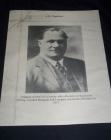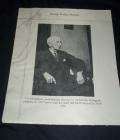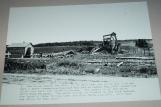2
THE MALAGASH MINEDid you ever hear tell of the Malagash Mine?
Way over in Cumberland, on the short line.
On the strait of Northumberland, there you'll find,
This well little place that is called the Salt Mine.
Once old Peter Murray
Who owned a fine farm,
Wanted some water for his house and his barn.
He employed Alex Gullons', to drill him a well
When they tasted the water 'twas salt as old hell.
Then along came prospectors
Called Chambers and MacKay,
And a shaft for the Salt Mine
Did sink right away.
Now its run by old Gliesbie
A man who's so fine,
All the boys try to please him
At the Malagash Mine.
There's young Dr. Harris
Who cures all their ills.
He has lots of good tonics
And lots of good pills.
He cures all their aches
And repairs to their bones,
And brings lots of "Little Miners"
To the Malagash homes.
Oh, Mr. Ed Long runs the Pool Room, you know
And old A. R. Mitchell the big talkie show.
When you're out of a job & haven't a dime,
It's two days a week at the Malagash Mine.
ANON
4
THE STORY OF MALAGASH SALTSalt springs in Nova Scotia were known by the Micmac Indians long before the advent of the European.
Many exploratory holes were drilled near these springs throughout the province. However, it took Peter Murray, a farmer of North Shore, Malagash, to spark the first true salt industry in the Province.
The men responsible for establishing the industry were A. R. Chambers, (1880-1937) an engineer at Wabana Iron Mines, Bell Island, Newfoundland; and George Walker MacKay (1880 - 1972) of New Glasgow; a McGill Graduate in Civil Engineering.
The existance of salt in the Malagash area of Cumberland County on Nova Scotia's north shore had long been known. Its worth realized by Chambers. In 1917 he convinced George Walker MacKay that a search for salt at Malagash was worth a try. The two formed a partnership and L. Herber Cole (a mining engineer working with the Federal Department of Mines) was brought to Malagash to oversee the diamond drilling. While Chambers remained in the employ of the steel company, MacKay overseered the drilling of test holes. A shaft was sunk, and on Labour Day, 1918, the first salt was hoisted. Salt in commercial quality and quantity was struck at the very shallow depth of 85 feet, and soon they were taking out salt at a rate of 30 to 40 tons a day. Horse wagons freighted the salt to the nearest rail point, eight miles away.
This was Canada's first rock salt mine. Until then all Canadian Salt came from the brine evaporation process. Chambers and MacKay continued as a partnership to develop the salt deposit.
6
A. R. CHAMBERS BIOGRAPHYA. Robert Chambers, well known to all his friends as "Bob", was born in New Glasgow, NS, in the year 1879.
After preliminary education in New Glasgow, Mr. Chambers entered the Faculty of Applied Science at McGill University and graduated as a Bachelor of Science (BSC) in Mining in 1904.
From 1904 until 1908 he was Mine Manager for the Wabana Iron Mines in Newfoundland, the vast ore deposits of which were discovered by his father. He was then designated Manager of Ore Mines and Quarries for the Nova Scotia Steel Company, and served in that capacity until 1917.
He then founded and became president of the Malagash Salt Company and devoted his life not only to the operation of the salt mine at Malagash but also by expanding the use of the product.
He displayed exceptional enterprise and tenacity. He was a pioneer in investigating and advocating the use of common salt to stabilize the surface of highways, and to him is due much credit for the progress already made in the practice in Canada and elswhere.
For over 25 years he was a member of the Canadian Institute of Mining and Metallurgy, to which he contributed several valuable scientific papers. He was highly esteemed and greatly beloved on account of a particularly happy and genial disposition by a host of friends in the engineering cicles of Montreal and throughout the Dominion and United States.
He also took a great interest in local matters as instanced by his deep interest in the rehabilitation of the Pictou Coal Fields. Also, at the time of his death, he was President of the New Glasgow Board of Trade.
He passed away on Saturday, December 4, 1937,at the age of 58.
8
GEORGE WALKER MACKAYGeorge Walker MacKay was born September 18, 1880. His father George Forrest MacKay was the founder (in New Glasgow) of the steel industry of Canada. He had been an original partner in the founding of Canada's first Salt Mine and his association dated from 1917, a span of 55 years.
It can be said of the Malagash ventures that A. R. Chambers had the ideas, the courage and the know how to begin the industry and George W. MacKay had the money. He had the money and was willing to gamble in a Nova Scotia industry. Few Nova Scotians have been so inclined preferring always to invest in areas remote from Eastern Canada. And a gamble it remained all his life; 41 years, but it never failed.
George W. MacKay said to John MacQuarrie in March, 1972, "We never made any money until we got into the highway salt business." MacKay died April 10, 1972, at the age of 92.
10
An extract from the interview with Kenny Wilson. Kenny tells us the story of how the salt mining began in 1918.So you know the story about how the mine got started don't you? Do you want to tell us that one as well?
Peter Murray was a farmer and the dug well that he had was not producing enough water for him to water his cattle. So he decided to hire a gentleman down the highway, I never knew his name, but was capable of boring a well. And the gentleman came, he just lived down the road about a mile, and he came up to Peter Murray's farm here where the mine was and he drilled, started drilling. Well after he struck water Peter Murray's hired hand, more or less, was Herb Wilson, a young fella. And the next day; this was in the winter time; and the next day when young Herb came up the road to go to work (he was about 14 years old Herb told me at the time), he noticed that the snow had melted all over he place away from the water where they had drilled, more than usual. Well he thought he'd just, that's a new well I must have a little drink of water, and he took a swig of this stuff and it was 100% brine, they had drilled right into the salt. He said he blew it all over the field too!
Melted some snow then I bet you!
And Peter Murray didn't do anything with it; he didn't know what to do. It was a dead well to him a terrible thing to happen really.
Yes.
He found out that his pork that he had, if he took water and put his pork in it in a barrel it was perfect, pickling. Right for pickling, right out of the ground. I remember one story he had taken a half a pig or something over to Tatamagouche to sell. A lot of the farmers did that, they raised so many pigs and they'd sell some to pay for the ones that they had, the ones they kept for themselves. And he offered it to I think it was Bill Langille, the fella who ran the meat market in Tatamagouche. And they asked Peter how did you get the pig so perfectly salted, so even. He said "Oh just the water out of my well". And the story got around after a while that he was telling the truth, you see. And MacKay and Chambers, two gentlemen from New Glasgow, one was an engineer and the other was an industrial type person. They heard about it and they came to Malagash to see what this was all about. And they were the founders of the salt mine. So they were the ones that sank the first shaft.
Yes.
So was that 1918 or 1919?
Er? 1918 they sunk the first shaft, from then it would be the next 1919, no wait a minute 1918 that's right. The first lump of salt came up on Labour Day, 1918.
So how deep did they go down, do you know how deep they went?
About 80 feet the first shaft.
12
FIRST SALT HOISTED LABOUR DAY, SEPT 2, 1918Diamond drilling was carried out in 1917.
Shaft sinking commenced Dominion Day, 1918. A crew of five men did the digging in the
almost impervious clay, which was loaded into a tub and hoisted to surface with block and tackle and gin pole and one horse.
On Labour Day, September 2nd, 1918, the first rock salt was mined in Canada.
13
Agreement between the mine founders and the land owners29 June 1917
Malagash, Nova Scotia, Canada

14
Agreement between the mine founders and the land owners29 June 1917
Malagash, Nova Scotia, Canada






